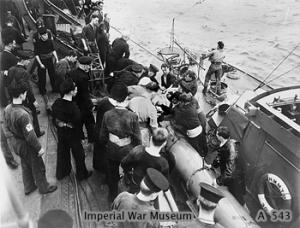Texel Disaster facts for kids
The Texel Disaster was a sad event that happened off the coast of the Netherlands on the night of August 31, 1940. During this time, World War II was happening. This disaster involved the sinking of two Royal Navy ships called destroyers. Another destroyer and a light cruiser were also damaged. The problem started when a group of destroyers, known as a flotilla, sailed into an area filled with hidden mines. This caused one ship to be badly damaged. Then, two more destroyers sank while trying to help the first one. A light cruiser, which was there to protect the ships, was also slightly damaged by a mine on its way back to port. In total, about 300 people died in this disaster. Another 100 sailors were either hurt or captured as prisoners of war.
What Happened During the Disaster?
On the night of August 31, 1940, a group of British ships, called the 20th Destroyer Flotilla, left a place called Immingham. Their mission was to place mines near the Dutch coast, close to an island called Texel. This group included ships like HMS Express, Esk, Icarus, Intrepid, and Ivanhoe. Other ships from the 5th Destroyer Flotilla, like HMS Kelvin, Jupiter, and Vortigern, also joined them.
While these ships were busy laying mines, British planes flying overhead saw something worrying. They spotted German ships moving west from Terschelling towards Britain. The British leaders worried this might be an invasion. So, they quickly told the 20th Flotilla to stop laying mines and go stop the German ships.
As the British ships headed towards the German force, they sailed right into a new minefield. This minefield was not on their maps. The ship Express hit a mine and was badly damaged. It lost most of its front part, called the bow. This explosion caused many injuries and deaths. Out of 175 sailors on board, 90 were killed or hurt. Even the ship's captain, J.G. Bickford, was injured.
Then, the ship Ivanhoe went to help the injured sailors from Express. But Ivanhoe also hit a mine and was badly damaged. This explosion killed 53 more sailors and hurt most of the rest of the crew. Later, the ship Esk also hit a mine. It sank, and 127 sailors from that ship died. Some life rafts with shipwrecked sailors floated to the Dutch coast. The German authorities captured these sailors and made them prisoners of war.
On September 1, the ships Kelvin and Jupiter from the 5th Flotilla arrived to help rescue the sailors. Later, two more light cruisers, HMS Aurora and Galatea, came to protect the rescue ships. The badly damaged Ivanhoe was sunk by fire from Kelvin so it wouldn't fall into enemy hands. The remaining ships then returned to port. Jupiter pulled the damaged Express until special tugboats could take over. On the way back, Galatea hit another mine but was only slightly damaged.
What Was the Result of the Disaster?
The Texel Disaster led to about 300 deaths. Another 100 sailors were either injured or captured. This was the biggest loss of life for the British Nore Command since the evacuation of Dunkirk. It turned out that the German "invasion force" was actually just a small group of ships laying mines. They were simply moving from Cuxhaven to Rotterdam.
The sight of so many injured sailors returning from the disaster, some with bad burns, led to a false story. People started to believe that a German invasion had been stopped by using burning oil on the sea. At the time, some British people and newspapers even blamed Lord Louis Mountbatten for the disaster.


